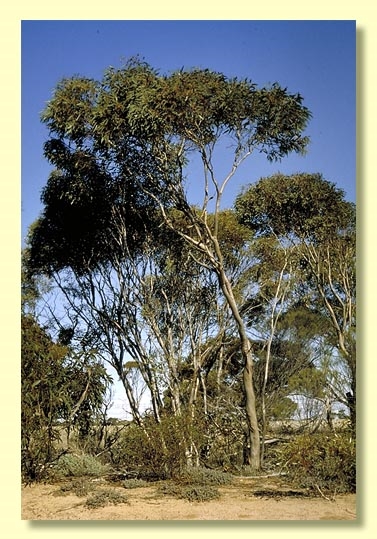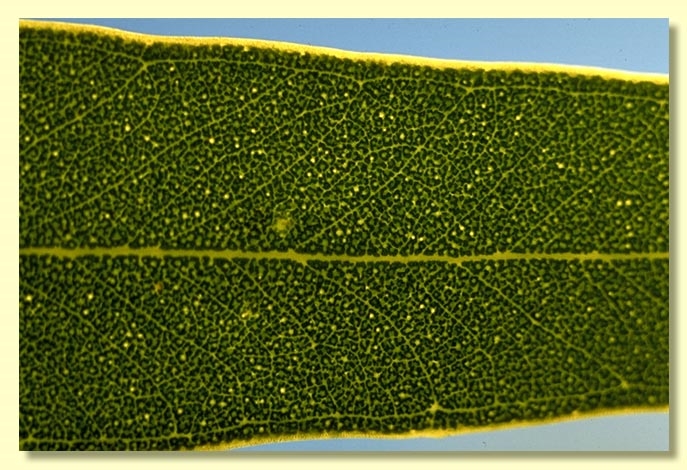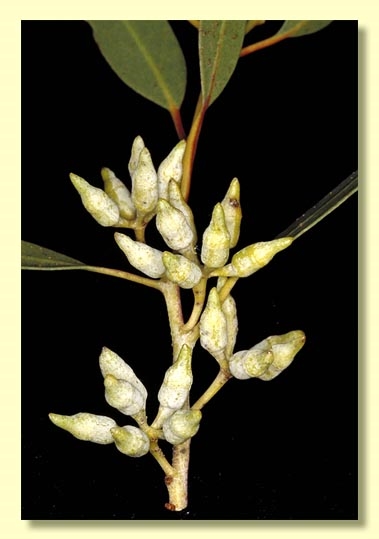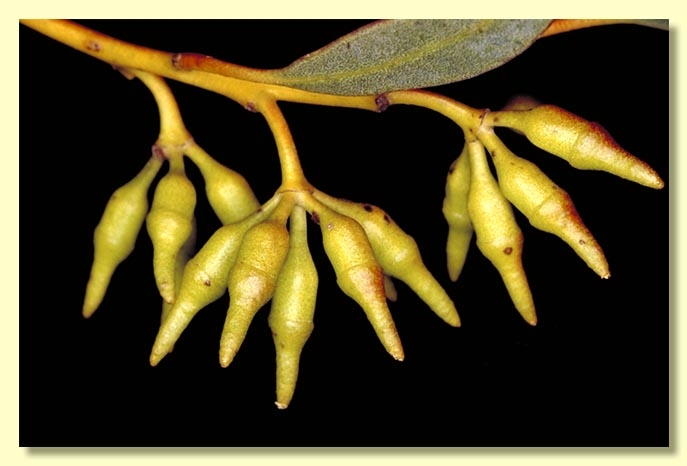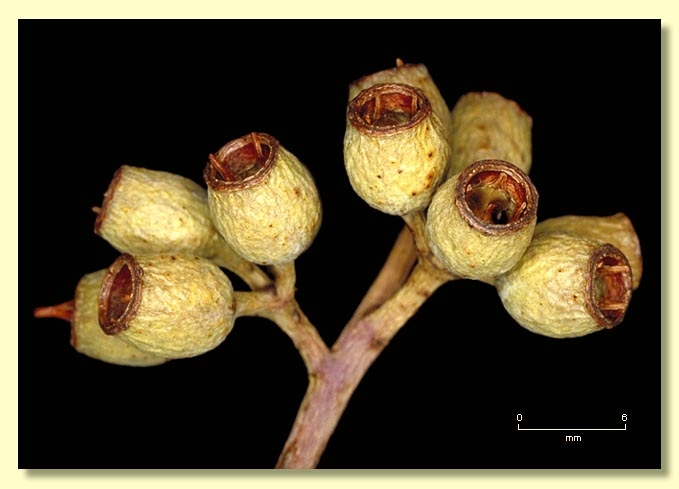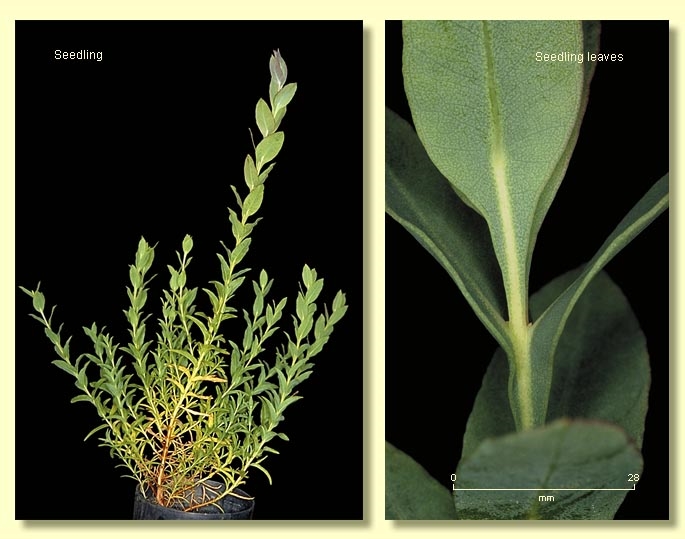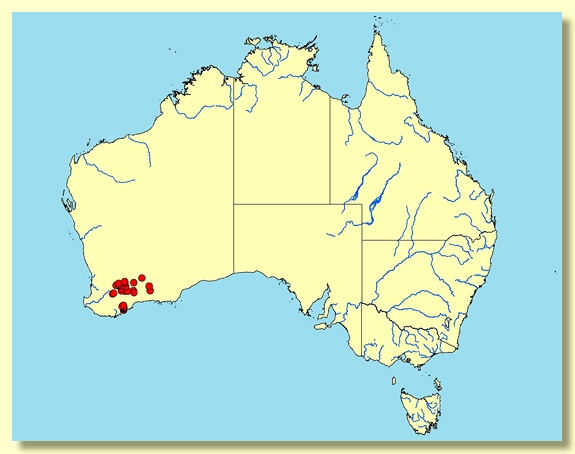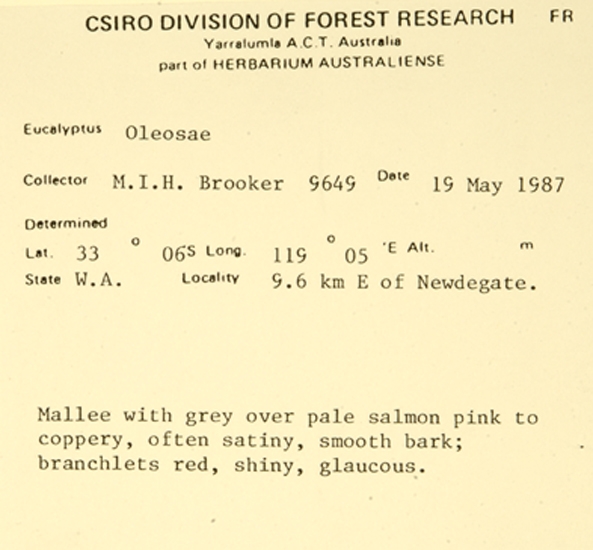Eucalyptus | Symphyomyrtus | Bisectae | Destitutae | Subulatae | Decurrentes
Euclid - Online edition
Eucalyptus neutra
Bark smooth throughout, grey over cream to brown to salmon-pink to coppery (rarely yellow).
Branchlets often slightly glaucous; lacking oil glands in the pith.
Juvenile growth (coppice or field seedlings to 50 cm): stem square to rounded in cross-section, glaucous; juvenile leaves opposite becoming alternate further up the stem, sessile to shortly petiolate, ovate to lanceolate, the bases of lower leaves decurrent on stem, becoming rounded to tapering further up the stem, margin entire, apex pointed, 3.5–8 cm long, 1.8–4 cm wide, glaucous.
Adult leaves alternate, petiole 1–2 cm long; blade lanceolate, 5–11(13.5) cm long, (0.7)1–2 cm wide, base tapering to petiole, concolorous, young leaves dull blue-green to rarely slightly glaucous, becoming glossy to slightly glossy green with age, side-veins at an acute or wider angle to midrib, densely reticulate, sometimes the reticulation obscure, intramarginal vein parallel to and just within margin, oil glands numerous and mostly intersectional.
Inflorescence axillary unbranched, peduncles 0.5–1.3 cm long, buds usually 7, rarely 9, pedicellate, pedicels 0.3–0.6 cm long. Mature buds ± ovoid (1.1–1.7 cm long, 0.3–0.6 cm wide), glaucous, scar present, operculum beaked to horn-shaped (0.7–1.2 cm long), stamens inflexed, anthers versatile, basifixed, globoid, dehiscing by broad slits, style long, stigma tapered, locules 3 or 4, the placentae each with 4 vertical ovule rows. Flowers pale yellow to white.
Fruit pedicellate, pedicels 0.2–0.5 cm long, barrel-shaped to truncate-globose, rarely urn-shaped, sometimes glaucous, 0.5–1 cm long, 0.5–0.8 cm wide, disc descending, valves 3 or 4, valve tips strongly exserted due to fragile style remnants.
Seeds glossy brown to grey, 1.2–2 mm long, ovoid or flattened-ovoid, rarely pointed at one end, occasionally with shallow longitudinal furrows on otherwise smooth dorsal surface, hilum ventral.
Cultivated seedlings (measured at node 10): cotyledons Y-shaped (bisected); stems square in cross-section and prominently winged due to decurrent leaf bases; leaves opposite, sessile, linear for the first few nodes then ovate to elliptical to lanceolate, dull grey-green to sometimes slightly glaucous on new growth, 1.2–6.7 cm long, 0.3–1.3(1.7) cm wide, leaf base decurrent on stem.
Flowering has been recorded in October and November.
A mallee of scattered occurrence in the south-central wheatbelt in Western Australia, from west of Lake King towards Corrigin and southwards to the Jerramungup area. The bark is smooth and the adult leaves slightly glossy to glossy, blue-green to grey-green, with the new growth duller. With its strongly decurrent juvenile leaves it has been placed with the E. flocktoniae group of species. However the slight waxy bloom suggests it is probably closer to the E. transcontinentalis group. Within both groups the smooth-barked mallee habit, slight glaucescence, and non-ribbed buds and fruit distinguish it.
Eucalyptus neutra belongs in Eucalyptus subgenus Symphyomyrtus section Bisectae subsection Destitutae because buds have two opercula, cotyledons are Y-shaped and branchlets lack oil glands in the pith. Within this subsection E. neutra is part of a large taxonomic series Subulatae further characterised by globoid basifixed anthers, grey smooth seeds with shallow longitudinal furrows, and fruit with persistent exserted style remnants. Series Subulatae is divided principally into four subseries based on the juvenile leaves, one with spiral, crowded seedling phyllotaxis (subseries Spirales), another with decussate and decurrent seedling leaves (subseries Decurrentes), another with decussate non-decurrent seedling leaves (subseries Decussatae), and a fourth with disjunct, petiolate seedling leaves (subseries Oleaginae).
Eucalyptus neutra is part of subseries Decurrentes. Within this group it is closely related to E. transcontinentalis and E. moderata. E. transcontinentalis differs by always being a well formed tree. E. moderata differs by having rough bark on the lower trunks. E. neutra is also close to E. flocktoniae, which differs by its non-glaucous branchlets, buds and fruit.
Specimens from the Pallinup River area east of Albany differ slightly from typical E. neutra by the tumble-down habit, the dull adult leaves and consistently glaucous buds and fruit. The Pallinup River form has informally been referred to as E. "mesopoda". It is now considered that these differences are due to coastal influences and it is regarded as being part of E. neutra.

